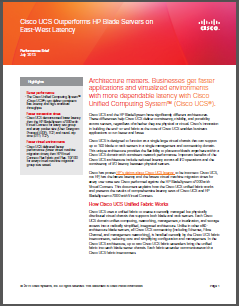































Virtualization, Private Cloud, Big Data, HPC, etc. have been steadily changing the landscape of data center architectures. Lower latency and higher performing server-to-server data traffic (East-West) have become key discussion points as customers look to modernize their infrastructures. Cisco specifically designed UCS unified fabric for this type of traffic to create a highly-available infrastructure with reduced latency and unmatched consistency as the solution scales. Without providing any supporting data, HP and IBM have been incorrectly asserting that Cisco UCS unified fabric would increase latency and slow blade-to-blade traffic. Cisco ran the tests, and the results were simply amazing.
Cisco UCS Outperforms HP Blade Servers on East-West Latency
Cisco UCS Outperforms IBM Flex System Blades on East-West Latency
"Cisco UCS demonstrated lower latency than the HP BladeSystem c7000 with Virtual Connect for every test group and every packet size (User Datagram Protocol [UDP], TCP, and round-trip time [RTT] TCP)."
"Cisco UCS delivered better performance than IBM (faster virtual machine migration times) for every group size tested." "As the virtual machine size and network load increases, the Cisco UCS performance advantage also increases."


HP and IBM blade architectures rely on placing networking switches (HP Virtual Connect; IBM Flex System Fabric Switches) inside of every 16 or 14 blade chassis. These legacy vendors imply that data can communicate from one blade to another more efficiently because their networking switches reside within the chassis. They fail to mention two critical points:
Not only does Cisco UCS outperform HP and IBM, but UCS clearly provides lower latency and faster VM timing by a wide margin. Thousands of East-West samples were collected, testing raw blade-to-blade latency (UDP/TCP/RTT TCP) and virtual machine migration times. Testing was performed on a number of different fabric topologies both within a single chassis (best case for HP and IBM) as well as across multiple chassis. We are excited to share these performance briefs and communicate a subset of this compelling data. Full details can be obtained under NDA from your Cisco representative.
 Tags quentes :
Cisco UCS
IBM
Hp
Cisco Unified Fabric
Cisco UCS Performance
Cisco UCS Fabric Interconnect (FI)
HP c-class bladesystem
blades
IBM Flex System
Tags quentes :
Cisco UCS
IBM
Hp
Cisco Unified Fabric
Cisco UCS Performance
Cisco UCS Fabric Interconnect (FI)
HP c-class bladesystem
blades
IBM Flex System